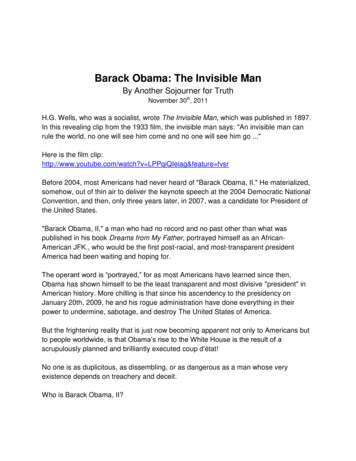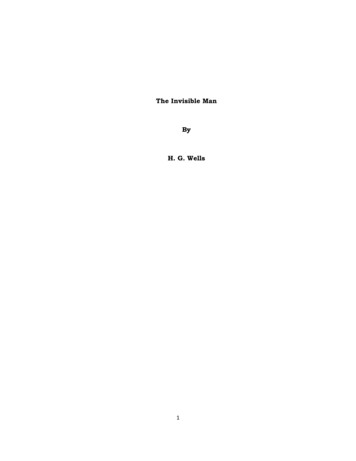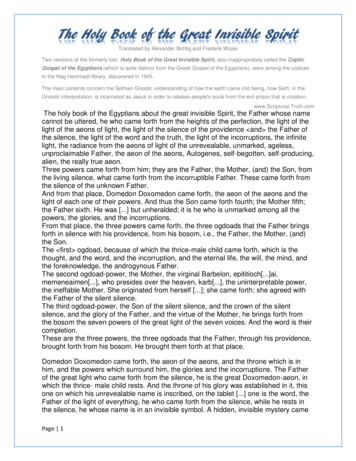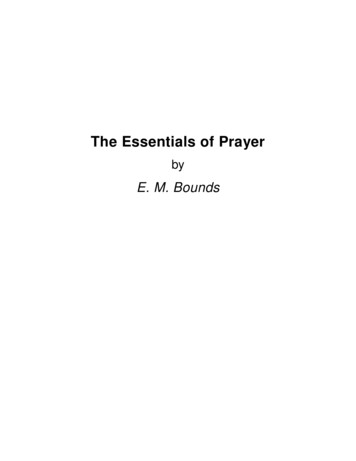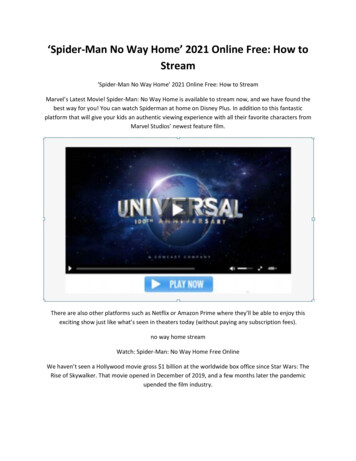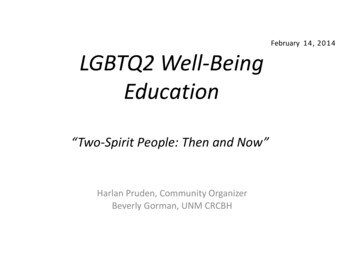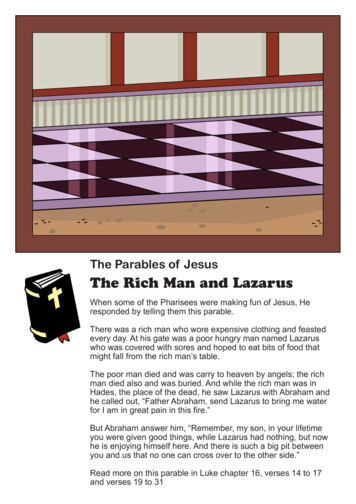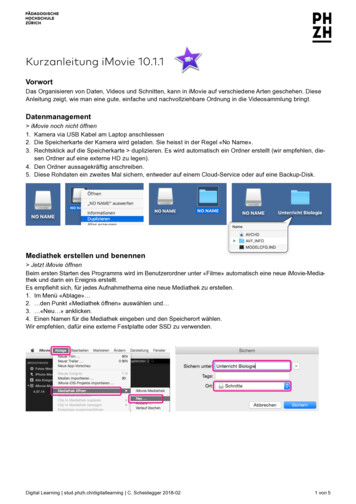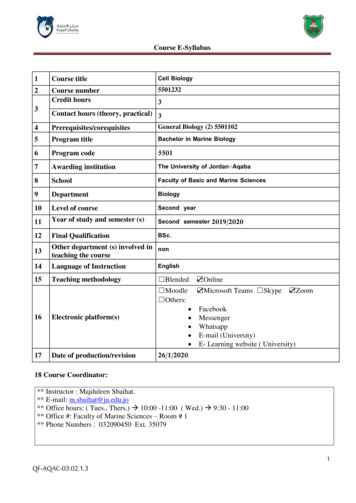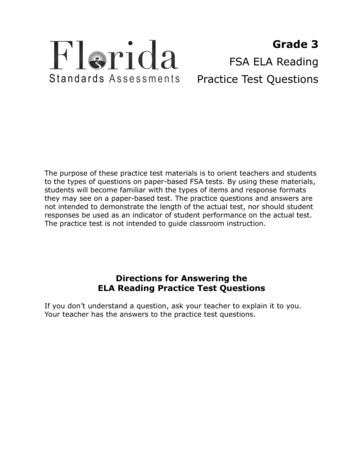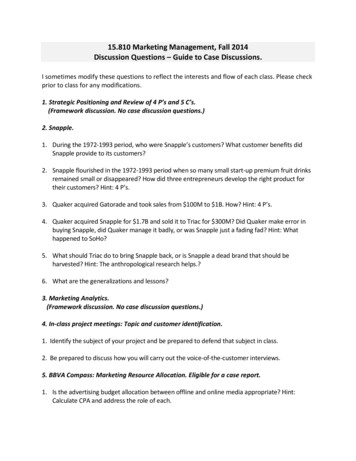
Transcription
Southfield Public LibraryInvisible Man by Ralph EllisonDiscussion Questions used at SPL January -- 20121.Did you feel like you were back in college, taking American Literature 301?2. Have any of you read this prior to book club? How long ago? Do you have a different take on itnow then you did the first time you read it?3. How important were those epigraphs? Why is our narrator nameless? Does that add to hisinvisibility? Why do you think he thought he was invisible? In his mind, was he ever visible?Was he invisible to both black and white society?4. How strong of a character was IM? What were his weaknesses? What do you think his hopesand dreams were? Was he a sympathetic character?5. Were there characters in the book that represent sources of moral authority and stability?6. At times, the use of language in this book was just amazing to me . . . When IM gave hisspeeches, or in descriptions . . . What do you think of Ellison’s writing style?7. Think about the impact this book made when it was published . . . It was written in the 40’s butnot published ‘til 1952 . . . what was life like in America? Especially for African Americans?8. How do you think this book was received at the time it was published? How do you perceive ittoday? What can we learn from it today?9. Who – or what - does the Invisible Man represent? Is he an everyman? Are his experiencesunique to African American culture?10. Did you feel that the same events occurred over and over again . . . How would you compare theopening Battle Royal to the fight at the Bar with Mr. Norton to the fight at the paint factory tothe battle in Harlem with Ras the Destroyer? Any other examples?11. What do you think of the reaction of the college president to IM taking Mr. Norton to those“forbidden” places? What did you think of his treatment of IM, sending him to NY with thoseawful letters?12. What do you think Ellison was trying to say about society in his depiction of Liberty Paint . . . Thewhitest paint ever, but the secret ingredient was 10 drops of black paint . . .
13. What do you think was going on in the paint factory with the Union meeting? Did that forecastany events in the book?14. What about his treatment at the factory’s hospital? Did that seem possible to you as a reader?How did it change IM’s life?15. Were you surprised at IM’s speech/oration at the eviction of the old couple? What gave him thecourage to speak to the crowd like that?16. Did the description of the belongings that were cast out on the street humanize the couple foryou?17. What was the Brotherhood? When you first read about them, what did you think their goalswere? Were you suspicious of them?18. Why did he join the Brotherhood? Why did the brotherhood choose him? How was he invisibleto them?19. When did he lose the support of Brother Jack? Did it matter to the IM that he had?20. What did you think of his grandfather’s philosophy . . . “yes ‘em” to death . . .21. What was his relationship to Tod Clifton – the other African - American man working for theBrotherhood? Did the Brotherhood set them up as competitors? Why do you think Tod fell outof the group? And why did he wind up selling those Sambo puppets? What do you think theauthor was trying to communicate with that?22. How did Tod’s murder affect him? What did he hope to accomplish with the funeral? What didyou think of his funeral speech?23. When he confronted Ras, after the funeral, he had to run for his safety. He donned a disguise white hat and sunglasses - and people thought he was someone named Rinehart . . .what did helearn from that experience?24. Do we, as a society, really see people or do we see types . . .25. His being mistaken for Rinehart opened his eyes to a lot of things . . . That many people areinvisible, that people will only see what they want to see about a person . . . Were there otherthings this deception changed in him?26. He wondered who was left who really knew him . . . did he even know who he was himself?27. Why did he stay in hibernation down in the coal cellar?28. Why did he decide it was time to rejoin the world?
29. In a Random House question, “Invisible Man may be said to exemplify the paranoid style ofAmerican Literature”. . . How does Ellison establish an atmosphere of paranoia in his novel?How is that paranoia appropriate to the subject matter of this book?30. Ellison was criticized by contemporaries for being insufficiently “Afrocentric.” Do you agree?Do you think he made artistic compromises in order to make Invisible Man accessible to whitereaders?31. Did you notice how it seemed Invisible Man was involved in so many layers of American society– from poor black sharecroppers to white rich society folks . . . how well did Ellison representthem? What did you take away from the dissection of society?32. What has changed in the 60 years since the book was published?33. This was considered controversial in its day . . . why do you think it was? In today’s society, is itstill?34. How did Ellison use music, specifically jazz, in his writing?35. Symbols are important in this book. How important were dreams to the Invisible Man? Whatabout the link of chain that Brother Tarp gave Invisible Man? What was his relationship withBrother Tarp?36. How were women perceived in this book?37. At the end of the book, the Invisible Man concludes that “even an invisible man has a sociallyresponsible role to play”. . . what do you think that role should be?
Southfield Public LibraryGeneral Discussion Questions For the person who chose the book – What made you want to read it? What made you pick itfor the book club? Did it live up to your expectations? How is the book structured? First person? Third person? Flashbacks? Narrative devices? Do youthink the author did a good job with it? How would you describe the author’s writing style? Concise? Flowery? How is language used inthis book? Read aloud a passage that really struck you. How does that passage relate to thebook as a whole? How effective is the author’s use of plot twists? Were you able to predict certain things beforethey happened? Did the author keep you guessing until the end? Did the book hold your interest? How important is the setting to the story? Did you feel like you were somewhere else? Did thetime setting make a difference in the story? Did the author provide enough backgroundinformation for you to understand the setting and time placement? Which is stronger in the book – the characters or the plots? Would you recommend this book to someone else? Why? And to whom?
Southfield Public LibraryInvisible ManQuestions taken from Reading Group Guidehttp://www.readinggroupguides.com/guides i/invisible man1.asp1. What makes Ellison's narrator invisible? What is the relationship between his invisibilityand other people's blindness--both involuntary and willful? Is the protagonist's invisibilitydue solely to his skin color? Is it only the novel's white characters who refuse to see him?2. One drawback of invisibility is that "you ache with the need to convince yourself that youdo exist in the real world" [p. 4]. How does the narrator try to prove that he exists? Doesthis sentence provide a clue to the behavior of other characters in the book?3. What are the narrator's dreams and goals? How are these variously fulfilled or thwartedin the course of the book?4. Is the reader meant to identify with the narrator? To sympathize with him? How do youthink Ellison himself sees his protagonist?5. What is the significance of the grandfather's deathbed speech [p.16]? Whom or what hashe betrayed? What other characters in this book resort to the same strategy of smilingbetrayal?6. Throughout the novel the narrator gives speeches, or tries to give them, to audiencesboth black and white, at venues that range from a whites-only "smoker" to the funeral of ablack street vendor murdered by the police. What role does oratory--and, more broadly, thespoken word--play in Invisible Man?7. The "battle royal" sequence portrays black men fighting each other for the entertainmentof whites. Does Ellison ever portray similar combats between blacks and whites? To whatend?8. Throughout the book the narrator encounters a number of white benefactors, including amillionaire college trustee, an amiable playboy, and the professional agitator Brother Jack.What does the outcome of these relationships suggest about the possibility of friendship orcooperation between the races?9. What black men does the protagonist choose as mentors or role models? Do they proveto be any more trustworthy than his white "benefactors"? What about those figures whoseauthority and advice the narrator rejects--for example, the vet in The Golden Day and theseparatist Ras the Exhorter? What characters in Invisible Man, if any, represent sources ofmoral authority and stability?10. What cultural tendencies or phenomena does Ellison hold up for satire in this novel? Forexample, what were the real-life models for the Founder, the Brotherhood, and Ras the
Exhorter? How does the author convey the failures and shortcomings of these people andmovements?11. Why might Tod Clifton have left the Brotherhood to peddle demeaning dancing Sambodolls? What does the narrator mean when he says: "It was as though he [Clifton] hadchosen.to fall outside of history"? How would you describe Ellison's vision of history andthe role that African-Americans play within it?12. Invisible Man may be said to exemplify the paranoid style of American literature. Howdoes Ellison establish an atmosphere of paranoia in his novel, as though the reader, alongwith the narrator, "had waded out into a shallow pool only to have the bottom drop out andthe water close over my head" [p.432]? Why is this style particularly appropriate to Ellison'ssubject matter?13. Where in Invisible Man does Ellison--who was trained as a musician--use language tomusical effect? (For example, compare the description of the college campus on pages 34-7to Trueblood's confession on 51-68, to the chapel scene on 110-135, and Tod Clifton'sfuneral on 450-461.) What different sorts of language does Ellison employ in these andother passages? How does the "music" of these sections--their rhythm, assonance, andalliteration--heighten their meaning or play against it?14. More than forty years after it was first published, Invisible Man is still one of the mostwidely read and widely taught books in the African-American literary canon. Why do youthink this is so? How true is this novel to the lives of black Americans in the 1990s?15. In spite of its vast success (or perhaps because of it), Ellison's novel--and the authorhimself--were fiercely criticized in some circles for being insufficiently "Afrocentric." Do youthink this is true? Do you think Ellison made artistic compromises in order to makeInvisible Man accessible to white readers?
Invisible Man by Ralph Ellison Discussion Questions used at SPL January -- 2012 1. Did you feel like you were back in college, taking American Literature 301? 2. Have any of you read this prior to book club? How long ago? Do you have a different take on it now then you did the first time you read it? 3. How important were those epigraphs?
